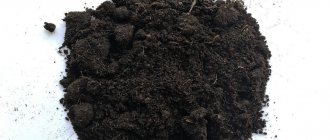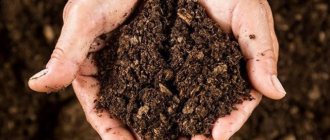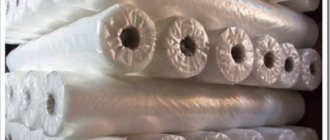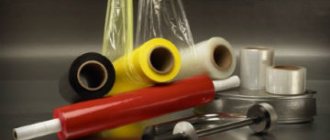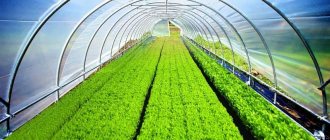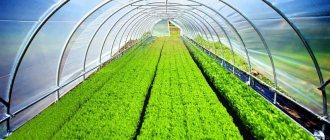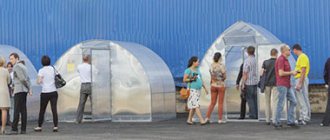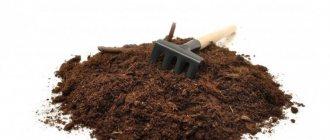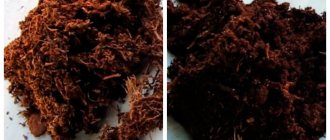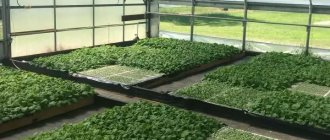What is peat, its composition and properties
Peat is a mineral formed by the decomposition of plants in wetlands.
The humidity in such places is high, and air does not penetrate into the depths of the swamp. Therefore, plants do not decompose completely, forming layers of valuable natural material. Peat composition:
- carbon 50-60%;
- hydrogen 5%;
- oxygen 1-3%;
- nitrogen 3%;
- sulfur 1%.
When burned, peat releases 24 MJ/kg of heat energy. The age of mineral deposits is 5-10 thousand years. But only 60 percent of wetlands produce peat.
Peat properties:
- dark brown or brown color;
- brittle;
- softer than glass;
- lighter than water;
- porous;
- absorbs moisture well;
- combustible.
The use of peat is also common. It is used :
- in the form of fuel: only peat with a medium or high degree of decomposition is suitable;
- in gardening as a fertilizer, for the production of peat tablets and cups for seedlings;
- in livestock farming: it is used as bedding for livestock;
- chemical industry;
- medicine.
Fresh peat is highly acidic and is not suitable for application to the soil, as it has a negative effect on plants.
Deposits in Russia and the world
176 million hectares is the area occupied by peat deposits in the world. While the total area of peatlands on the planet (undeveloped deposits) is estimated at 421 million hectares. The distribution of deposit territories among the leading countries of the world is as follows:
- 56.8 million hectares – Russia.
- 29.2 million hectares – CIS countries.
- 26.0 million hectares – Indonesia.
- 12.9 million hectares - Canada.
- 10.2 million hectares - USA (excluding Alaska).
- 10.0 million hectares – Finland.
The largest deposits in Russia are located in Siberia - this is about 80% of mineral deposits. The Tomsk region is especially rich in peat reserves, having on its territory the largest Vasyugan swamps in the world. In their place are the following deposits:
- Vasyuganskoye – 2310.4 thousand hectares
- Konovalovskoye-Yugorskoye-Karasye – 373.5 thousand hectares.
- Pasol and Kogot – 210.3 thousand hectares.
- Maloe Vasyuganskoye – 141.7 thousand hectares.
- Lebyazhye-Isanskoye – 53.3 thousand hectares.
In addition to them, the region also contains peat deposits:
- Ozernoye Bolshoye – 572.4 thousand hectares,
- AndryushkinoII – 77.7 thousand hectares,
- Alexandrovskoye – 75 thousand hectares,
- Kulai – 72 thousand hectares.
Types of peat
There are three types of this fossil: high peat, low peat and neutral. They differ in their depth and some properties.
Horse
High peat is formed in the process of interaction and decay of spruce and sphagnum moss with sediments. This top layer is loose, decomposes slowly and contains most of the air.
It is mined in the upper layers of swamps. Often interacts with open air. Mostly composed of sphagnum moss. This moss is light.
Used for the manufacture of filter elements and cleaning systems. Also used as fuel and insulating material.
This peat does not contain weeds and parasites, which is why it is well suited for filling in greenhouses. It is also used as bedding for livestock.
What components can be used for the substrate?
Peat is practically ordinary humus. It is used not only as fertilizer, but also as fuel. It can be replaced with other components, which during the process of decay will also become fertilizer. For this you can use:
- manure;
- sawdust;
- wood chips;
- tyrsa;
- bark;
- ash.
We advise you to read how many years after planting and how often blueberries bear fruit.
Tyrsa
It is not difficult to prepare the optimal soil for planting blueberries using tyrsa. Every gardener, even a beginner, can do this. It is a mixture of sand and sawdust, which is used when planting seedlings . A similar substrate with fertilizing elements is poured into the hole to maximum fertilize the plant.
wood chips
The combination of components for soil fertilization can be different. It is worth preparing the fertilizer shortly before use so that the components do not contaminate. Large wood waste is often used - chips, which during the process of decay release useful substances into the ground . In combination with sawdust, tyrsa and crushed bark, you get an ideal environment for crop growth.
Sawdust
The use of sawdust in home gardening is widespread. It is with their help that bushes are insulated for the winter and mulched . Sawdust, along with other components, is also used as fertilizer when planting blueberries. It is necessary to take fresh ones, since those that have been lying around for a certain time may be rotten.
Bark
Tree bark is excellent for forming a substrate. It contains many useful substances, which during composting the soil will absorb them and subsequently become richer . The only thing worth doing is to chop the bark a little before using it. It is recommended to use most often material from pine, since it contains a substance that does not allow diseases and fungi to develop in blueberry roots.
The benefits and harms of peat for soil and plants
Indeed, this substrate can bring not only benefits, but also harm.
Summer residents often add peat in large quantities, without paying attention to what type it is. Thus, they risk damaging the soil and the plants growing on it.
Benefit
- At minimal cost it can improve soil characteristics and increase the amount of harvest.
- The use of peat increases the layer of humus in the soil. The land is becoming more fertile.
- Makes the soil porous, facilitating access of air and moisture to plant roots.
- Able to fight unwanted microorganisms, bacteria and fungi.
- Increases and decreases soil acidity, depending on the type of peat.
- Promotes rapid warming of the soil.
- Stops leaching of nutrients.
- It accumulates moisture, thereby moistening the soil, which is good for dry areas.
Peat plays the role of a natural filter for external and underground waters. It rids it of harmful compounds and heavy metals.
Harm
- If applied incorrectly, in dosage, or in combination with some fertilizers, it can reduce plant growth. Sometimes, unwise use of peat can lead to the death of garden crops.
- May cause increased acidity in the soil. This also negatively affects plants. To reduce acidity, peat is mixed with slaked lime (100 kg of peat and 5-6 kg of lime).
- It makes no sense to introduce peat into fertile and loose soil. It won't do any good. In such soil, only 5% of the nutrients from peat will be absorbed.
Due to insufficient watering, peat clumps can shrink, which will lead to drying out of the plant root system.
DIY substrate for blueberries, proportions
Suitable soil for growing blueberries is rare. To get out of this situation, you can independently make a substrate that resembles an ideal environment for the plant. The proportion of components when preparing the mixture yourself should look something like this:
- sawdust, wood chips - about 60%;
- pine bark - 10%;
- local soil - 40%.
This combination will create optimal conditions and soil acidity for growing blueberries at home.
Video: How to prepare a substrate for planting blueberries
Peat compost
Regardless of what kind of peat you use, lowland or highland, it is more advisable to use it together with other fertilizers, because in some cases, peat in its pure form can be not only useless, but also dangerous.
The best solution is to make peat compost. It may include ash, sawdust, tops, mowed grass, food waste, etc.
It is recommended to arrange a compost heap with a diameter of 2 * 2 m, away from plantings and resting places, preferably in the shade.
Lay the compost heap in layers in the following sequence:
When all the layers are laid, the peat compost is left to rot for 1-1.5 years. The height of the compost heap should not exceed 1.5 meters. In summer it is recommended to cover it with a canopy to protect it from direct sunlight, in the fall to cover it with dry leaves, high peat, soil, branches, etc., and in winter to cover it with snow.
From time to time, the compost heap must be moistened with water with the addition of superphosphate. It is recommended to mix the pile several times during the summer so that the top and bottom layers change places.
The finished compost is evenly distributed over the ground before sowing, added to the holes before planting, and sprinkled near trees and shrubs (10-20 kg of fertilizer per 10 m2 of soil).
Mistakes of novice gardeners
Proper application of peat fertilizers improves soil structure, promotes better growth and development of plants, as well as increased fertility and productivity.
sells and delivers high-quality high-moor and low-lying peat at the best price. Our company has its own fleet of vehicles and all the necessary production facilities, so you can order delivery of peat in any volume throughout Moscow or the Moscow region, or arrange pickup and pick up the goods yourself.
Source
Correct humus
It’s not for nothing that many experienced summer residents believe that the best elixir of fertility is manure. There are no diseases in it, although there are a lot of weed seeds, especially in the spring, when cattle are still fed with hay for the winter.
“I carry manure from the farm,” explains the driver of the Japanese truck, Alexey. – The quality is good, and good manure should not be liquid, it should have bedding - straw or sawdust.
A ton of manure on a farm costs about 400 rubles; gardeners sell it from trucks for 1 thousand rubles. About the same cost for tons of humus with peat. Experienced gardeners make humus from manure themselves, without the risk of introducing diseases or weeds into the area.
“When you make compost from manure, when it burns, most of the weed seeds die, and all pathogenic microbiota also die, because the pile heats up to 40–50 degrees, and this is how the compost is disinfected,” says Lyudmila Karengina.
In addition to manure, you can put peat, sawdust, and plant residues in this compost. By the way, do not try to make compost from pig manure - it is considered the “coldest” and practically does not burn. It is better for gardeners not to purchase it. Horse and sheep manure goes well into compost, as well as the most accessible one - mullein.
It is not necessary to prepare the correct humus yourself on the site; it can be purchased by searching on the Internet for the websites of companies specializing in the delivery of such materials. Partners of such companies themselves prepare humus based on manure and peat on farms. If the buyer wishes, they even do a laboratory analysis of it, although special certification of humus or manure is not required by law. But when buying peat, ask whether its development is certified.
Plot
"House. Garden. Vegetable garden" Features and secrets of gardening in the Middle Urals.
Source
How to get the best elixir of fertility: peat, manure or humus
When buying cars with black soil and soil on the roadsides, you risk introducing plant diseases and pests to the area. Photo: Vladimir Martyanov
All gardeners want the soil on their plots to be fertile. To do this, they often import peat, manure, humus, black soil and even sand by truck. But they are not always satisfied with the results obtained. How to improve the quality of the soil on the site by introducing imported materials without harming it?
